1992 VOLKSWAGEN CARAVELLE Driver
[x] Cancel search: DriverPage 52 of 164

Downloaded from www.Manualslib.com manuals search engine
CONTROLS AND EQUIPMENT
JB70-
1251
Switches
Notes
• On vehicles
with
righthand drive the ar rangement of the switches differs. The
symbols
on the switches are however the
same
as on vehicles
with
lefthand drive.
• The use of the lighting described here is subject to local regulations.
1 -
Lighting
switch
-n
First
detent -side lights11
Second
detent -headlight high/low beams
The
headlights only work when the ignition
is
on. When the engine is being started and
after ignition has been switched off, the headlights are switched off automatically.
When
the side lights are on, a warning lamp lights up in the switch.
When
the lights are on, the level of the in strument lighting can be regulated by turning the knurled disc on the
right
of the
switch.
Dipping and flashing the headlights - see
page
52. 2 -
Headlight
range
control
* %\_)
With the electrical range control the
head
light settings can be matched exactly to the
load
condition of vehicle. This prevents on
coming traffic from being
dazzled
more than
is
unavoidable. At the same time the correct headlight beam setting provides the best
possible
visibility for the driver.
The
headlights can only be regulated
with
the dipped headlights switched on.
To
lower the beams,
turn
knurled disc from
the
basic
position (-) downwards.
Note
The
basic
headlight setting (only possible
with
headlight adjusting appliance) must al
ways
be done
with
the headlight headlight range control knurled disc in the
basic
posi
tion (-) - see page 128
also.
On
vehicles for some export countries when
the side lights are switched on
with
the igni
tion switched on, the dipped headlights also
come
on
with
reduced intensity.
50
www.vwT4camper.info - a useful website for owners and enthusiasts of VW T4 Transporter Campervans
Page 72 of 164

Downloaded from www.Manualslib.com manuals search engine
CONTROLS AND
EQUIPMENT
Sun
roof*
The roof is opened and closed
with
the
hand-wheel.
The roof can be
tilted
at the rear as desired or taken out altogether.
Raising
Turn the hand-wheel clockwise.
Lowering
Turn the hand-wheel anti-clockwise.
To take
out
• With the roof closed
turn
the retaining
screw
(A) in centre of the hand-wheel one
quarter
turn
clockwise
with
a screwdriver.
• Then raise the roof and press it up.
•
Press
up locking lever (B).
• Detach the
roof.
•
Lift
the roof from outside and pull it out to the rear.
To
put
back
• Slide the roof back
into
the hinges and let it drop lightly
into
the retainers.
Attention Ensure that
the
roof
is
properly
inserted into
the two
retaining
hinges
at the
front,
and
secured
at
the
rear.
The roof must only
be
released when vehicle
is
stationary.
70
www.vwT4camper.info - a useful website for owners and enthusiasts of VW T4 Transporter Campervans
Page 73 of 164
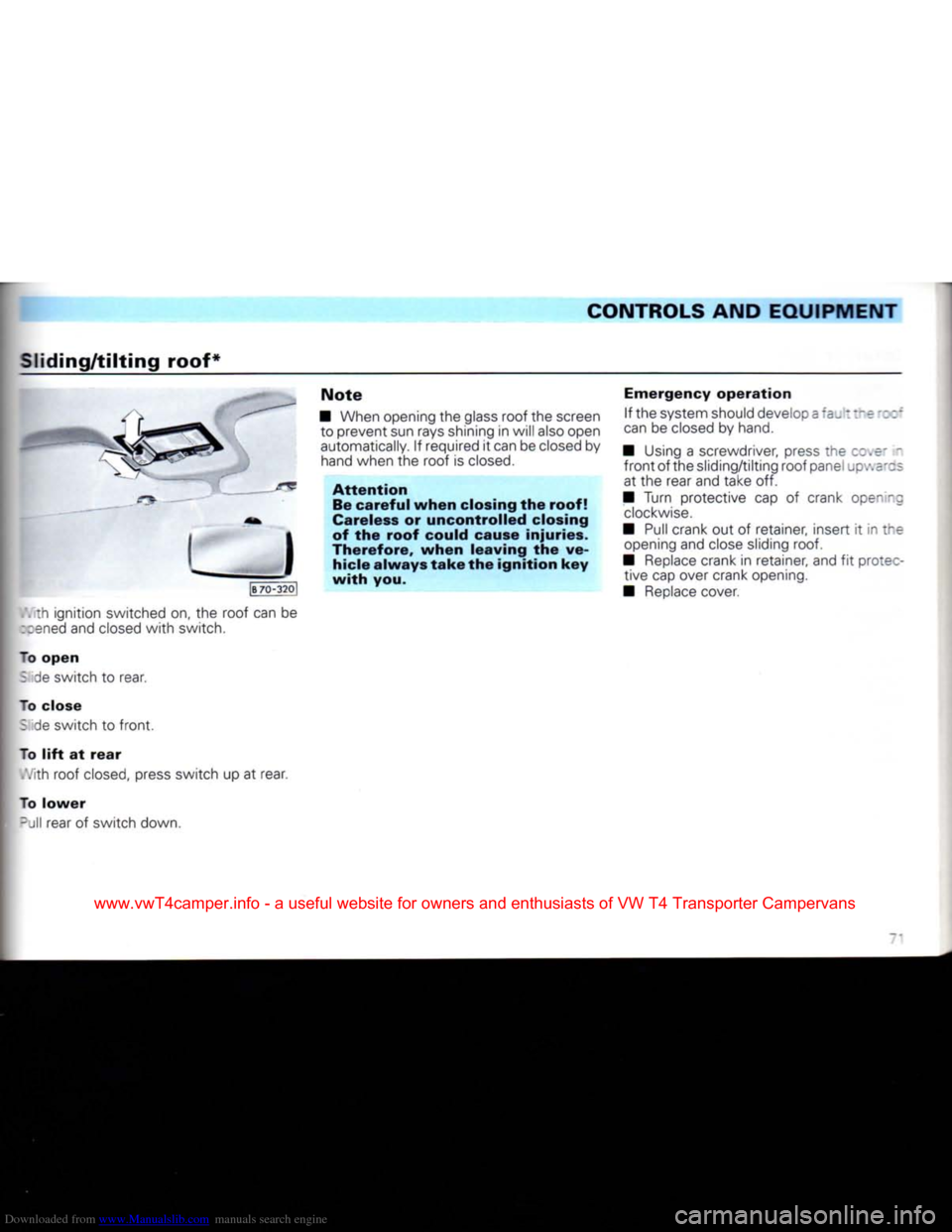
Downloaded from www.Manualslib.com manuals search engine
CONTROLS AND
EQUIPMENT
Sliding/tilting
roof*
! I I
[B
70-3201
. th ignition switched on, the roof can be
::ened
and closed
with
switch.
~o
open
: de switch to rear.
To close : de switch to
front.
To
lift
at
rear
,','ith
roof closed, press switch up at rear.
To
lower
-JII
rear of switch down.
Note
• When opening the glass roof the screen to prevent sun rays shining in will also open
automatically. If required it can be closed by hand when the roof is closed.
Attention
Be
careful
when
closing the
roof!
Careless or
uncontrolled
closing
of the
roof
could cause
injuries.
Therefore,
when
leaving
the ve
hicle
always
take
the
ignition
key
with
you.
Emergency
operation
If the system should develop a t:~e
can
be closed by hand.
• Using a screwdriver, press the cove' -
front
of the sliding/tilting roof panel upv.e'os at the rear and take off.
• Turn protective cap of crank opening
clockwise.
• Pull crank out of retainer, insert it in i^e opening and close sliding
roof.
• Replace crank in retainer, and fit protec tive cap over crank opening.
• Replace cover.
www.vwT4camper.info - a useful website for owners and enthusiasts of VW T4 Transporter Campervans
Page 80 of 164
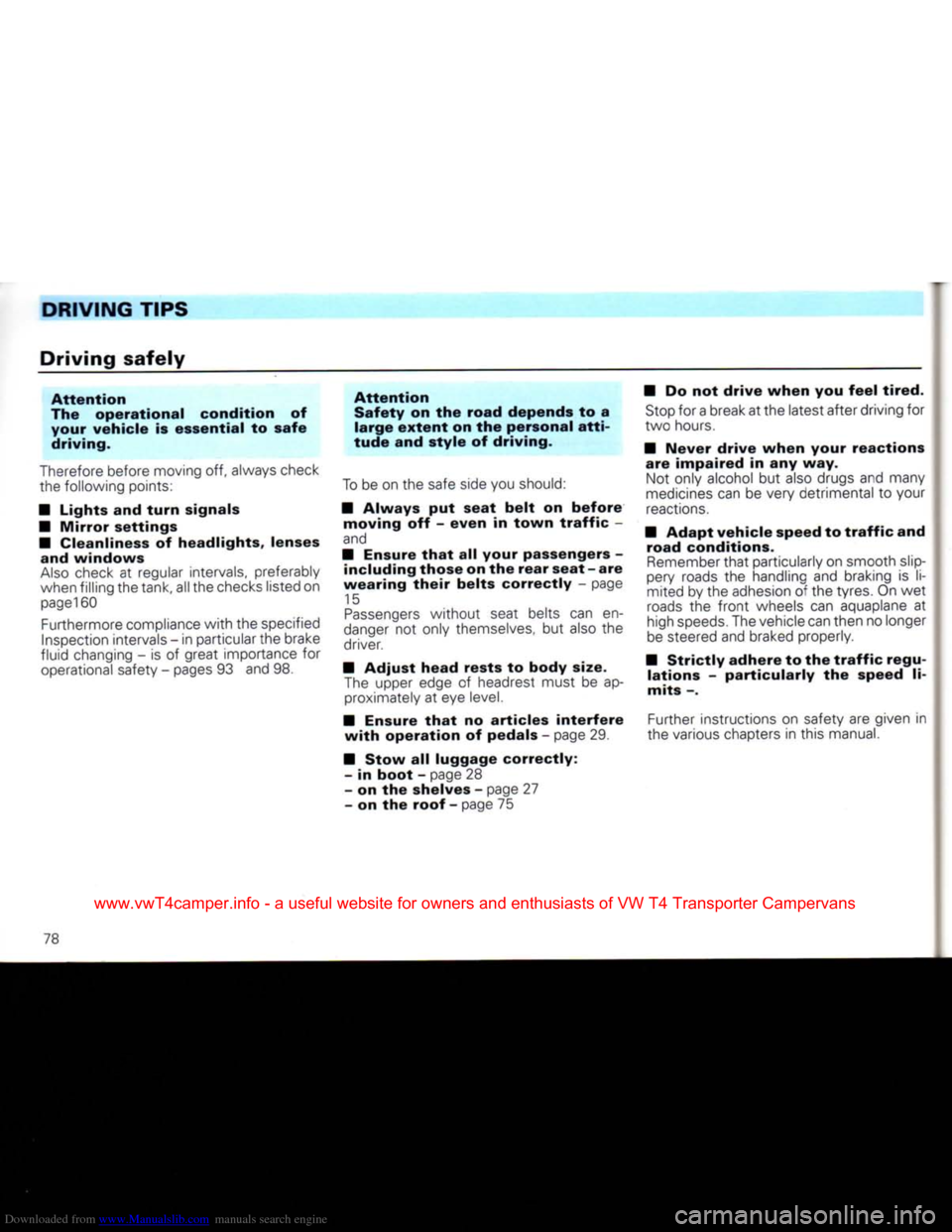
Downloaded from www.Manualslib.com manuals search engine
DRIVING
TIPS
Driving
safely
Attention
The
operational
condition of your
vehicle
is
essential
to
safe
driving.
Therefore before moving off, always check
the following points:
• Lights and
turn
signals
•
Mirror
settings
• Cleanliness of
headlights,
lenses and
windows
Also
check at regular intervals, preferably
when filling the tank, all the checks listed on
page160
Furthermore compliance
with
the specified Inspection intervals - in particular the brake
fluid changing - is of great importance for operational safety - pages 93 and 98.
Attention
Safety
on the
road
depends to a
large
extent
on the personal
atti
tude
and
style
of driving.
To
be on the safe side you should:
•
Always
put
seat
belt
on
before
moving
off -
even
in
town
traffic
-
and
• Ensure
that
all your passengers - including
those
on the
rear
seat
- are
wearing
their
belts
correctly
- page
15
Passengers
without seat belts can en
danger
not only themselves, but also the
driver.
•
Adjust
head
rests
to body size.
The
upper edge of headrest must be approximately at eye
level.
• Ensure
that
no
articles
interfere
with
operation
of pedals - page 29
•
Stow
all
luggage
correctly:
- in
boot
- page 28
- on the shelves - page 27
- on the
roof
- page 75 • Do not
drive
when
you
feel
tired.
Stop
for a break at the latest after driving for
two hours.
•
Never
drive
when
your
reactions
are
impaired
in any way. Not only alcohol but also drugs and many
medicines
can be very detrimental to your
reactions.
•
Adapt
vehicle
speed to
traffic
and
road
conditions.
Remember
that
particularly on smooth slip
pery roads the handling and braking is li
mited by the adhesion of the tyres. On wet
roads
the
front
wheels can aquaplane at
high
speeds.
The vehicle can then no longer
be
steered and braked properly.
•
Strictly
adhere
to the
traffic
regu
lations
-
particularly
the speed li
mits
-.
Further instructions on safety are given in
the various chapters in this manual.
78
www.vwT4camper.info - a useful website for owners and enthusiasts of VW T4 Transporter Campervans
Page 81 of 164
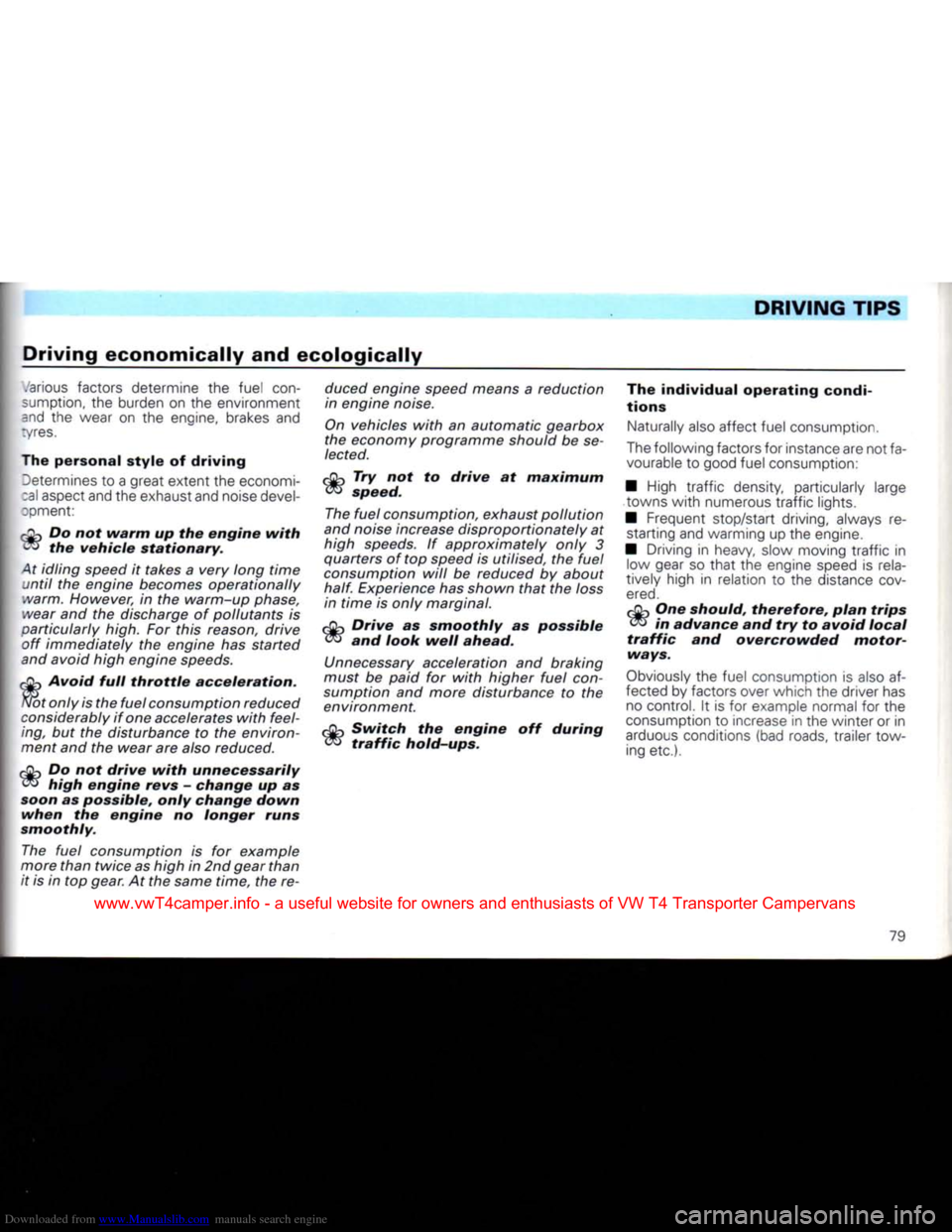
Downloaded from www.Manualslib.com manuals search engine
DRIVING
TIPS
Driving economically and ecologically
.'arious
factors determine the fuel
con
sumption,
the burden on the environment
and
the wear on the engine, brakes and
lyres.
The personal style of driving
Determines
to a great extent the economi-
:al
aspect and the exhaust and noise
devel
opment:
jOp
Do not
warm
up the
engine
with
W» the
vehicle
stationary.
At idling speed it takes a very long
time
until
the engine becomes operationally
warm. However, in the warm-up phase,
wear and the discharge of pollutants is
oarticularly high. For
this
reason, drive
off immediately the engine has started
and avoid
high
engine speeds.
f
h Avoid
full
throttle
acceleration.
of only is the
fuel
consumption reduced
considerably
if one accelerates
with
feel
ing, but the disturbance to the environ
ment
and the wear are also reduced.
rflri
Do not
drive
with
unnecessarily
high
engine
revs
-
change
up as
soon as possible,
only
change
down
when
the
engine
no
longer
runs
smoothly.
The
fuel
consumption is for example
more
than
twice as
high
in 2nd gear
than
it is in top
gear.
At the same
time,
the re duced engine speed means a reduction
in engine noise.
On vehicles
with
an automatic gearbox
the economy programme should be se
lected.
c^p
Try not to
drive
at
maximum
TO
speed.
The
fuel
consumption, exhaust pollution
and noise increase disproportionately at
high
speeds. If approximately only 3
quarters of top speed is utilised, the
fuel
consumption
will
be reduced by about
half.
Experience has shown
that
the loss in
time
is only marginal.
c
j-,
Drive
as
smoothly
as possible and
look
well
ahead.
Unnecessary
acceleration and braking
must
be paid for
with
higher
fuel
con
sumption and more disturbance to the environment.
Switch
the
engine
off
during
hold-ups. The individual
operating
condi
tions
Naturally
also
affect fuel consumption.
The
following factors for instance are not fa
vourable
to good fuel consumption:
•
High traffic density, particularly large
.towns with numerous traffic lights.
•
Frequent stop/start driving, always restarting and warming up the engine.
•
Driving in heavy, slow moving traffic in
low
gear so that the engine speed is
rela
tively high in relation to the distance cov
ered.
CQ~, One
should,
therefore,
plan
trips
in
advance
and try to
avoid
local
traffic
and
overcrowded
motor
ways.
Obviously
the fuel consumption is
also
af
fected
by factors over which the driver has
no
control. It is for example normal for the
consumption
to increase in the winter or in
arduous
conditions (bad roads, trailer tow ing etc.).
79
www.vwT4camper.info - a useful website for owners and enthusiasts of VW T4 Transporter Campervans
Page 83 of 164
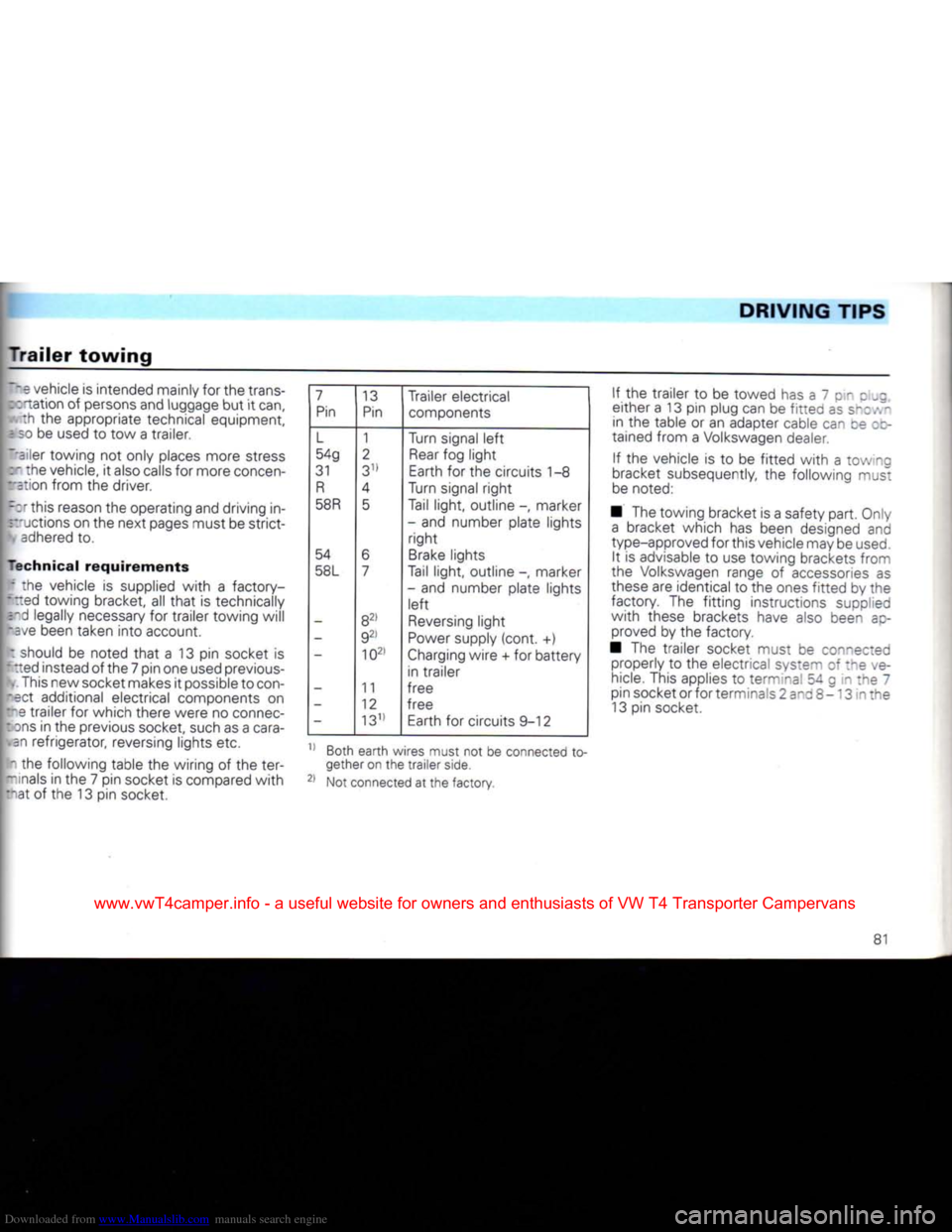
Downloaded from www.Manualslib.com manuals search engine
DRIVING
TIPS
Trailer
towing
~~e
vehicle is intended mainly for the trans-
cctation of persons and luggage but it can, th the appropriate technical equipment,
=
so be used to tow a trailer.
Ibiler towing not only places more stress : - the vehicle, it also calls for more concen-
ration from the driver.
::r this reason the operating and driving inductions on the next pages must be strict- . adhered to.
Technical
requirements
" :he vehicle is supplied
with
a factory-
• ::ed towing bracket, all
that
is technically -
d
legally necessary for trailer towing will =ve been taken into account.
: should be noted
that
a 13 pin socket is
::ed
instead of the 7 pin one used previous- . This new socket makes it possible to con-
ect additional electrical components on trailer for which there were no connec-
ns
in the previous socket, such as a
cara-
n refrigerator, reversing lights etc.
the following table the wiring of the ter-
nals
in the 7 pin socket is compared
with
at of the 13 pin socket.
I a 7
13
Trailer electrical
Pin Pin
components
L
1 Turn signal
left
54g
2
Rear
fog light
31
311
Earth
for the circuits 1-8
R
4
Turn signal
right
58
R
5
Tail
light, outline -, marker
- and number plate lights
right
54 6
Brake
lights
58L
7
Tail
light, outline -, marker
- and number plate lights
left
- 82>
Reversing
light
-
92!
Power
supply (cont. +)
-
102!
Charging
wire + for battery
in trailer
- 11
free
- 12
free
-
1311
Earth
for circuits 9-12
1) Both earth wires must not be connected to gether on the trailer side.
21 Not connected at the factory. If the trailer to be towed has a 7 pin plug,
either a 13 pin plug can be
fitted
as shown
in the table or an adapter cable can ce zz-
tained from a Volkswagen dealer.
If the vehicle is to be
fitted
with
a towing
bracket subsequently, the following must
be
noted:
• The towing bracket is a safety part. Only
a
bracket which has been designed and
type-approved for this vehicle may be
used.
It is advisable to use towing brackets from
the Volkswagen range of accessories as
these
are identical to the ones
fitted
by the
factory. The
fitting
instructions supplied
with
these brackets have also been ap proved by the factory.
• The trailer socket must be connected properly to the electrical system of the ve
hicle.
This applies to terminal 54 g in the 7
pin socket or for terminals 2 and 8 -13 in the
13
pin socket.
81
www.vwT4camper.info - a useful website for owners and enthusiasts of VW T4 Transporter Campervans
Page 86 of 164
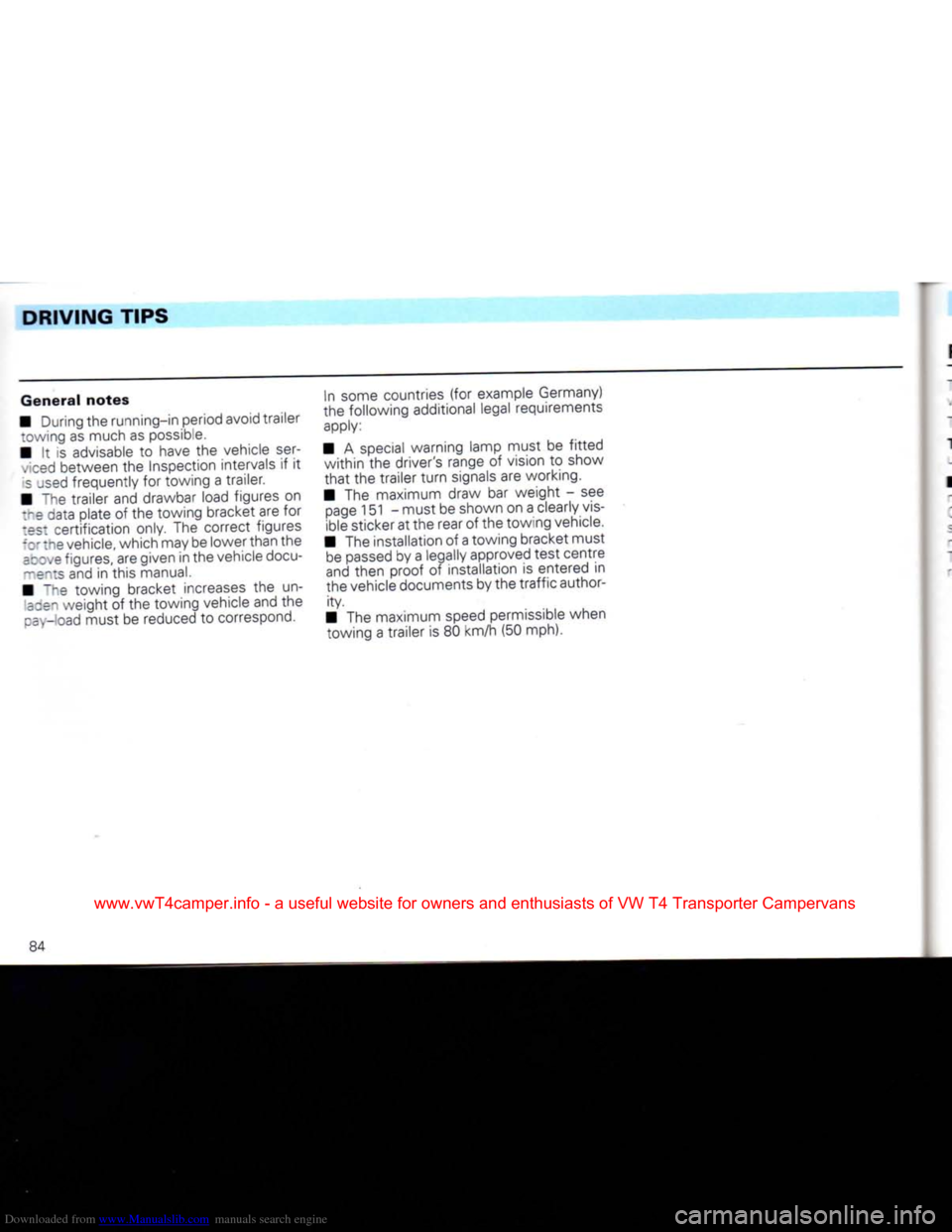
Downloaded from www.Manualslib.com manuals search engine
DRIVING
TIPS
General
notes
• During the running-in period avoid trailer "owing as much as possible.
• It is advisable to have the vehicle ser-
.ced
between the Inspection intervals if it
s
used frequently for towing a trailer.
• ""he trailer and drawbar load figures on
:re
data plate of the towing bracket are for
:es:
certification only. The correct figures
forthe
vehicle, which may be lower than the
acove
figures, are given in the vehicle docu-
~e~:s
and in this manual.
• The towing bracket increases the un-
535"
weight of the towing vehicle and the
pay-load
must be reduced to correspond. In some countries (for example Germany)
the following additional legal requirements
apply:
• A special warning lamp must be
fitted
within
the driver's range of vision to show
that
the trailer
turn
signals are working.
• The maximum draw bar weight - see
page
151 - must be shown on a clearly
vis
ible sticker at the rear of the towing vehicle.
• The installation of a towing bracket must
be
passed by a legally approved test centre
and
then proof of installation is entered in
the vehicle documents by the
traffic
author ity.
• The maximum speed permissible when towing a trailer is 80 km/h (50 mph).
84
www.vwT4camper.info - a useful website for owners and enthusiasts of VW T4 Transporter Campervans
Page 112 of 164
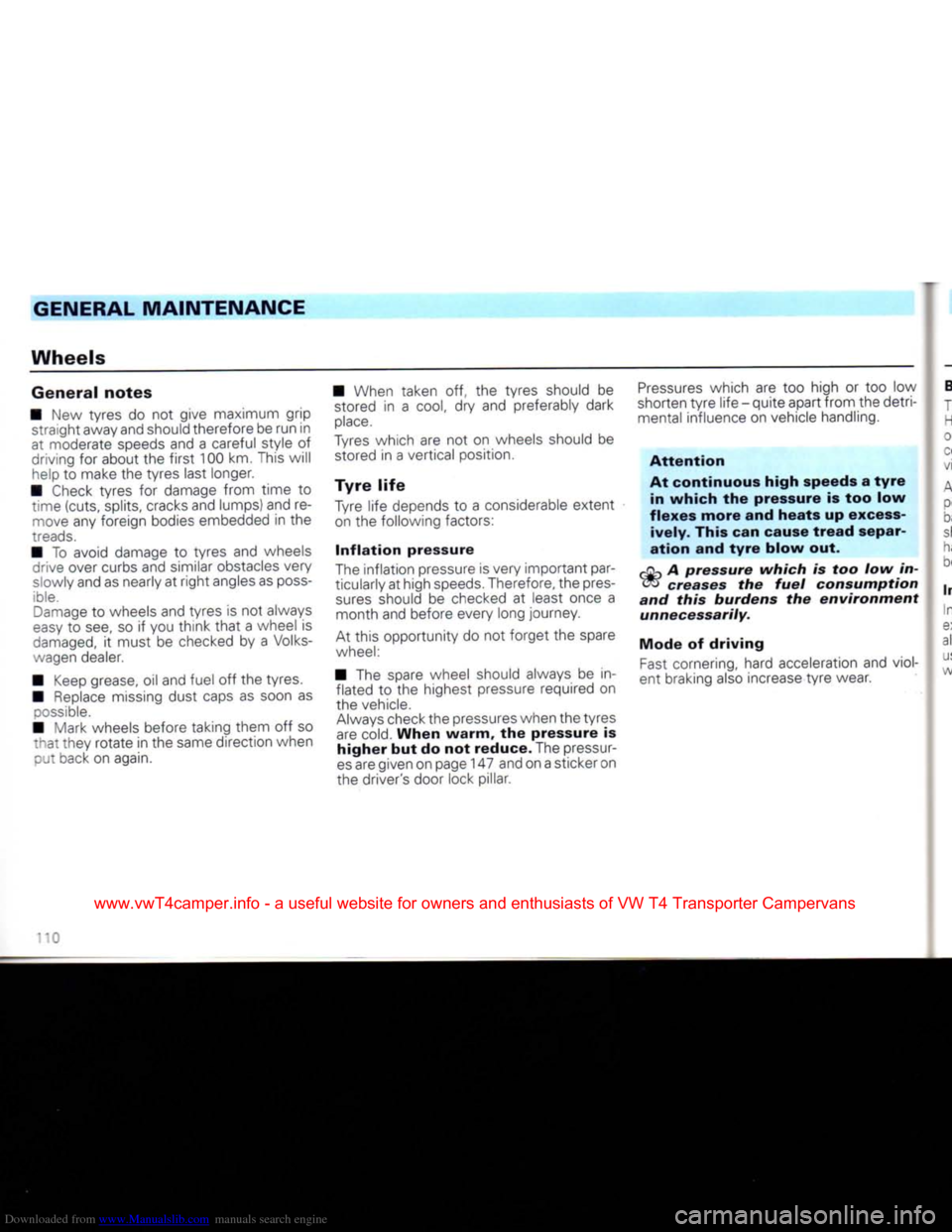
Downloaded from www.Manualslib.com manuals search engine
GENERAL
MAINTENANCE
Wheels
General
notes
• New tyres do not give maximum grip straight away and should therefore be run in
at moderate speeds and a careful style of
driving for about the
first
100 km. This will help to make the tyres last longer.
• Check tyres for damage from time to time (cuts, splits, cracks and lumps) and remove any foreign bodies embedded in the
treads.
• To avoid damage to tyres and wheels crive over curbs and similar obstacles very
slowly and as nearly at
right
angles as
poss
ible.
Damage
to wheels and tyres is not always
easy
to see, so if you
think
that
a wheel is
damaged,
it must be checked by a Volks
wagen dealer.
• Keep grease, oil and fuel off the tyres.
• Replace missing dust caps as soon as
possible.
• Mark wheels before taking them off so
that
they rotate in the same direction when put back on again. • When taken off, the tyres should be
stored in a
cool,
dry and preferably dark
place.
Tyres
which are not on wheels should be stored in a vertical position.
Tyre
life
Tyre life depends to a considerable extent on the following factors:
Inflation
pressure
The inflation pressure is very important par
ticularly at high
speeds.
Therefore, the pres
sures
should be checked at least once a month and before every long journey.
At this opportunity do not forget the spare
wheel:
• The spare wheel should always be in flated to the highest pressure required on
the vehicle.
Always
check the pressures when the tyres are cold.
When
warm,
the pressure is
higher
but do not
reduce.
The pressur
es
are given on page 147 and on a sticker on
the driver's door lock pillar.
Pressures
which are too high or too low
shorten
tyre
life - quite apart from the detri mental influence on vehicle handling.
Attention
At
continuous
high
speeds a
tyre
in
which
the pressure is too low
flexes
more
and
heats
up excess
ively.
This can cause
tread
separ
ation
and
tyre
blow
out.
pCU
A
pressure
which
is too low in- oo
creases
the
fuel
consumption
and
this
burdens
the
environment
unnecessarily.
Mode
of
driving
Fast
cornering, hard acceleration and viol
ent braking also increase
tyre
wear.
'0
www.vwT4camper.info - a useful website for owners and enthusiasts of VW T4 Transporter Campervans